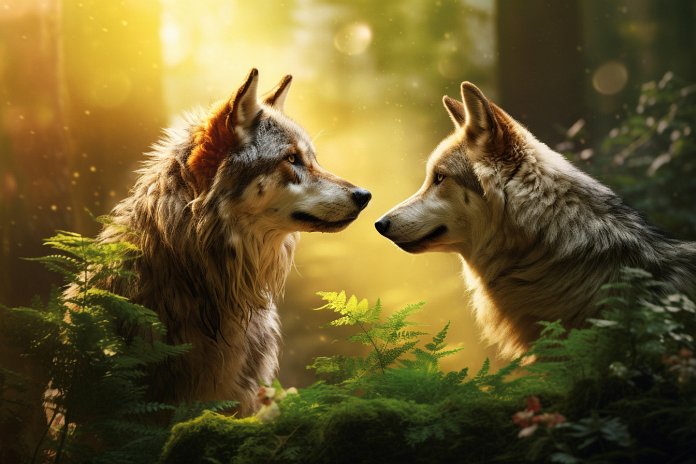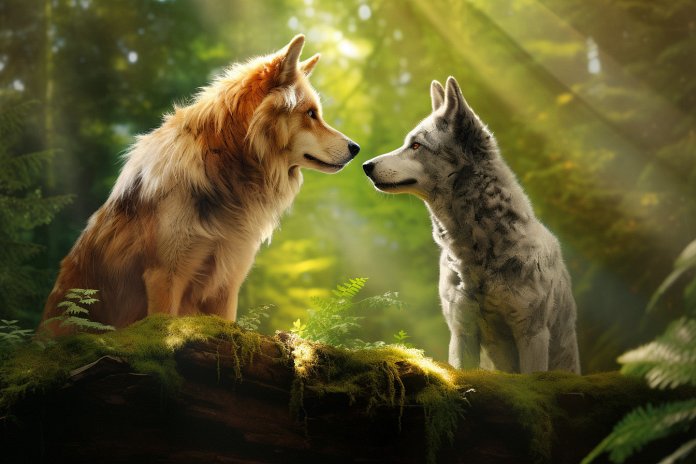
Dogs and wolves are closely related, so it’s natural to wonder if they can understand and communicate with each other. Dogs often display wolf-like behavior, and wolves occasionally show domestic dog-like behavior. Research suggests that dogs and wolves can actually understand each other to some extent, despite differences in their language and communication styles.
Signs of Dogs and Wolves Understanding Each Other:
There are several behaviors that dogs and wolves share, showing their understanding of each other. For example, dogs and wolves both greet each other by licking faces. Additionally, dogs will hold a gaze and follow eye movements, just like wolves do when they are around humans. Both species can also understand finger pointing and engage in howling. Dogs and wolves also exhibit similar body language when they want to play, show dominance or submission, or display aggression.
Body Language:
Some signs of wolf-like behavior in dogs include growling, alertness, listening, howling, dropped ears, and pacing. Other signs include playing and chasing their tails, greeting their pack, needing social interaction, and staying close to their pack.
History of Dogs and Wolves:
Dogs and wolves have evolved separately for about 15,000 years, although the exact timeline is still debated. During this evolution, wolves started to become domesticated and transformed into the dogs we know today. Their heads became smaller, their teeth became smaller, and they became more docile and affectionate. The exact origins of domestication are still uncertain, as it could have happened in Europe, the Middle East, or East Asia. It is also unclear whether humans tamed dogs or if wolves domesticated themselves by being around humans.
Science Behind Dogs and Wolves:
Recent studies have provided more insight into the domestication and relationship between dogs and wolves. Mitochondrial genome comparisons suggest that dogs were domesticated in Europe or Western Siberia between 18,800 and 32,100 years ago. Another study proposes that wolves were domesticated in China around 33,000 years ago. Dogs and wolves share 98.9% of their genes, resulting in many shared physical traits, communication styles, social interaction, territorial instincts, and behaviors. Wolves and dogs can also cultivate human attachment, although wolves are less dependent on humans than dogs.
Training Dogs and Wolves to Communicate:
At present, there is no known method to train dogs and wolves to communicate or understand each other. It is not advisable to attempt this, as they are two distinct species, and wolves, especially those in the wild, can be dangerous.
“Understanding the Language of Wolves and Dogs: A Tale of Similarities and Differences”

Tips & Things to Know
1️⃣ Dogs and wolves share similar body language and communication styles, such as howling, playing, and displaying dominance. Recognizing these behaviors in your dog can help you understand their wolf-like instincts and tendencies.
2️⃣ Dogs and wolves have a long history of evolution and domestication, but the exact timeline and process are still debated among scientists. It is believed that wolves started to morph into domesticated dogs through close interaction with humans.
3️⃣ While dogs and wolves share many physical traits and genes, it is not recommended to train them to communicate with each other. They are inherently different species, and wolves, especially those in the wild, can be dangerous.
Frequently Asked Questions, Answered ✅
1. Can dogs and wolves understand and communicate with each other?
– Yes, dogs and wolves can understand each other to some extent, although there are differences in their language and communication styles.
2. What are some signs that dogs and wolves understand each other?
– Some signs include licking faces as a form of greeting, holding gaze and following eye movements, understanding finger pointing, and howling.
3. Do dogs and wolves have similar body language communication?
– Yes, both dogs and wolves exhibit similar body language when it comes to play behavior, dominance, submission, and aggression.
4. How did dogs evolve from wolves?
– Through about 15,000 years of evolution, dogs have become domesticated and have undergone physical changes such as smaller heads and teeth, as well as developing docile and loving behaviors.
5. What does scientific research say about the relationship between dogs and wolves?
– Studies suggest that dogs were likely domesticated in either Europe or Western Siberia around 18,800 to 32,100 years ago, while wolves may have been domesticated in China around 33,000 years ago. The genes of dogs and wolves are 98.9% similar, and both species can cultivate human attachment. However, training dogs and wolves to communicate is not advised due to their inherent differences and potential dangers.